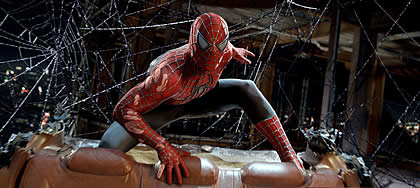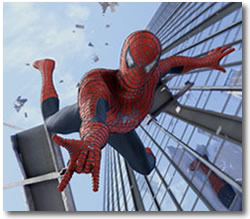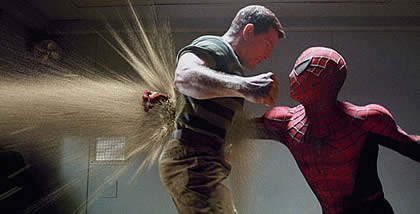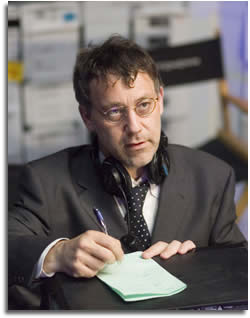 As I watch SPIDER-MAN 3, for some insane reason I keep humming the fabled song, "Spider-Man, Spider-Man, does whatever a spider can." Those last few words stick in my mind: "...does whatever a spider can." I have always thought that the SPIDER-MAN films would have been the perfect action film franchise for the filmmakers to create a style of fighting based on the attack strategies of the spider.
As I watch SPIDER-MAN 3, for some insane reason I keep humming the fabled song, "Spider-Man, Spider-Man, does whatever a spider can." Those last few words stick in my mind: "...does whatever a spider can." I have always thought that the SPIDER-MAN films would have been the perfect action film franchise for the filmmakers to create a style of fighting based on the attack strategies of the spider.
I worked with Sam Raimi as his fight choreographer on the ABC TV series SPY GAMES (1996-97). During a few of our conversations back then, he spoke very highly of Hong Kong martial arts films (Raimi is the man responsible for bringing John Woo to Hollywood). Raimi was quite aware that many martial arts styles were based on animal movements and that even films like THE FIVE VENOMS developed animal styles solely for the movies--styles that did not exist in real life.
So, over the course of three SPIDER-MAN films, has Raimi created a style of fighting for Spider-Man based on spiders? Do the films take advantage of the repertoire of fighting behaviors employed by a spider to subdue its opponent? At the end of the day can Tobey Maguire as Spider-Man/Peter Parker do whatever a spider can?
In case you might not know, spiders belong to the phylum Arthropoda (the only extent of their relationship with insects), subphylum Chelicerata (based on fanglike chelicerae mouthparts compared to an insect's mandible mouthparts), class Arachnida (includes ticks, mites, scorpions), order Araneida. They have eight, seven-segmented legs, no antenna, breath through organs called book lungs and have 6 finger-like structures called spinnerets at the tip of the abdomen, from which the silk emerges. The thought of Spider-Man ejecting his web like a real spider conjures up some far-out and freaky images, but the films have simplified that behavior.

Spiders employ two kinds of predator/prey maneuvers. The first is the sit and wait strategy, in which the spider makes a web, and then sits on or near it and waits for something to become ensnared (examples include black widow, brown recluse, and garden spiders). The second is the pursuit strategy, in which a spider actually stalks, chases, leaps or jumps onto its prey (examples include hunting, jumping and wolf spiders).
In addition, spiders employ a wide array of cool behaviors that Spider-Man could also have used. The tarantula brushes what are called urdicating hairs from its abdomen with its hind legs and literally shoots the hairs at its prey (similar to a porcupine). The bolus spider spins a web ball at the end of a thin silk line, flings it into the air to catch the breeze, and essentially paraglides to new hunting grounds (called ballooning). The spitting spider spits out a mucilaginous (gummy or gelatinous) substance that engulfs and traps prey in its tracks.

When asked if he'd considered using these techniques, Raimi laughingly comments, "Well, good examples, and I must say that like any director directing SPIDER-MAN, of course I've studied the spider, all different genuses. I don't want to embarrass you with my knowledge but I think it's safe to say that we've examined that and have thought about it and as you've seen, some aspects of spider behavior have become an integral part of the pictures."
As with any major franchise, when the box office goes up, so does the budget of the next sequel, and this has certainly proven true with the SPIDER-MAN films. SPIDER-MAN was undoubtedly the biggest surprise of 2002 (incidentally, the initial treatment of this film was written by James Cameron). With a budget of $139 million, it earned $114.8 million its first weekend and went on to gross $403.7 million and $821.6 million in the U.S. and worldwide, respectively. SPIDER-MAN 2's budget of $200 million saw its opening weekend rake in $88.1 million with total grosses of $373.5 million and $784 million in the U.S. and the world, respectively. SPIDER-MAN 3's budget comes in at whopping $258 million, with a publicity and advertising budget of some $75 million.

Raimi's clever updates of the Spider-Man character have enable Spidey to successfully transcend that awful spandex look from the THE AMAZING SPIDER-MAN (1978) television series that starred Nicholas Hammond as Spider-Man. "Since he's been bitten by a spider (the film uses a genetically altered spider compared to the comic book's radioactive spider, reflecting the scientific paranoia of both time periods), our Spider-Man has indeed taken on the powers of a real spider like climbing walls, the ability to leap like some spiders, a spider's great proportionate strength and of course the various uses of web spinning and web shooting that Spider-Man has perfected over the past several films."
 Raimi has made several daring decisions in regard to the fight scenes in his SPIDER-MAN films. For example, when the first SPIDER-MAN was being shot, it was at the height of the Hong Kong fight choreography phenomena that had finally captured the imagination of Hollywood, finding expression in films such as THE MATRIX, CHARLIE'S ANGELS, and CROUCHING TIGER, HIDDEN DRAGON. Raimi being a staunch supporter of Hong Kong wire action and an ardent fan of the father of Hong Kong's outrageous "wire-fu," Ching Siu-tung, he resisted the urge to copy the action and instead kept the fight scenes believably physical and called in people from the world-renowned Cirque de Soleil to enhance the intricate wirework.
Raimi has made several daring decisions in regard to the fight scenes in his SPIDER-MAN films. For example, when the first SPIDER-MAN was being shot, it was at the height of the Hong Kong fight choreography phenomena that had finally captured the imagination of Hollywood, finding expression in films such as THE MATRIX, CHARLIE'S ANGELS, and CROUCHING TIGER, HIDDEN DRAGON. Raimi being a staunch supporter of Hong Kong wire action and an ardent fan of the father of Hong Kong's outrageous "wire-fu," Ching Siu-tung, he resisted the urge to copy the action and instead kept the fight scenes believably physical and called in people from the world-renowned Cirque de Soleil to enhance the intricate wirework.
"As you know, we really tapped into the action, sensibilities and wire gags of Ching Siu-tung and Tsui Hark's films when we did HERCULES and XENA, where XENA was really our version of Bridgette Lin Ching-hsia. In fact, when we pitched Universal Studios for the show, we simply showed clips of Lin and other Hong Kong action film like Tsui's ONCE UPON A TIME IN CHINA, Ching's SWORDSMAN and Ronny Yu's BRIDE WITH WHITE HAIR, and simply said Xena would do this. No one back then knew of these films and they were sold by them. But you have to remember, Spider-Man was never and still is not a martial artist."
 By the time SPIDER-MAN 2 came around, Raimi wanted to make the action look different and it was at this time that he added a bit of Hong Kong flavor by using Dion Lam, at one time Ching's protégé. Lam was also a good choice because he not only worked as a fight choreographer on MATRIX but he was also the action director on Hong Kong's first special effects-laden movie STORMRIDERS, so he extensively knew how to work with CGI technologies.
By the time SPIDER-MAN 2 came around, Raimi wanted to make the action look different and it was at this time that he added a bit of Hong Kong flavor by using Dion Lam, at one time Ching's protégé. Lam was also a good choice because he not only worked as a fight choreographer on MATRIX but he was also the action director on Hong Kong's first special effects-laden movie STORMRIDERS, so he extensively knew how to work with CGI technologies.
So what about SPIDER-MAN 3?
Raimi says, "The heart of the Spider-Man films has always been the depth of the characters and their interconnected lives. Peter's love of Mary Jane Watson and his friendship with Harry Osborn have always been the richest parts of our stories. When developing this third installment, we asked ourselves, 'What does this young man still have to learn?' We placed him in situations where he would be forced to confront his absences of character, obstacles that, in previous stories, he might not have been able to surmount. In this way, he would either be defeated or grow into the heroic person capable of overcoming these obstacles. As the depth of our characters grows, they become richer human beings and can achieve more than in the previous films."
 In SPIDER-MAN 3, Peter Parker has finally managed to strike a balance between his devotion to M.J. (Kirsten Dunst) and his duties as a superhero. But there is a storm brewing on the horizon and in a twist of horror film fate, Spider-Man's suit suddenly changes; it turns a foreboding black and yet enhances his powers. In a sense, Peter must now wrestle with the Dark Side as his psyche quickly descends into an Anakin Skywalker-like furor, where pride, overconfidence, and misplaced love-struck loyalty could destroy him and those around him. As two of the most-feared villains yet, Sandman/Flint Marko (Thomas Haden Church) and Venom/Eddie Brock (Topher Grace), gather unparalleled power and a thirst for retribution, Peter must also battle his greatest foe?the growing evil within himself. Spider-Man will need to rediscover the compassion that makes him who he is?a hero.
In SPIDER-MAN 3, Peter Parker has finally managed to strike a balance between his devotion to M.J. (Kirsten Dunst) and his duties as a superhero. But there is a storm brewing on the horizon and in a twist of horror film fate, Spider-Man's suit suddenly changes; it turns a foreboding black and yet enhances his powers. In a sense, Peter must now wrestle with the Dark Side as his psyche quickly descends into an Anakin Skywalker-like furor, where pride, overconfidence, and misplaced love-struck loyalty could destroy him and those around him. As two of the most-feared villains yet, Sandman/Flint Marko (Thomas Haden Church) and Venom/Eddie Brock (Topher Grace), gather unparalleled power and a thirst for retribution, Peter must also battle his greatest foe?the growing evil within himself. Spider-Man will need to rediscover the compassion that makes him who he is?a hero.
The Sandman first appeared in "The Amazing Spider-Man" #4 in 1963 and Venom first appeared in the 1980s in "The Amazing Spider-Man" #298. "With every villain," Raimi says, "they are a reflection of Peter and the struggles he endures as he comes of age. So we're basically holding up a mirror, where each character is there with a purpose ? part of the thread of Peter's life.
 "Sandman is that intangible aspect of a villain. What if you punch your opponent, and there's suddenly nothing there but a cloud of dust? The beauty of Sandman is it is like battling a Swiss Army knife. You think you've got him figured out, then he morphs into a sand cloud, or levels his hammer fist at you, or becomes a pile of sand. When I saw how Thomas Haden Church acted in his film SIDEWAYS and presented a character with warmth and humanity and grace ? even as the character consistently made all the wrong choices ? we knew he could do the same for this classic Marvel villain."
"Sandman is that intangible aspect of a villain. What if you punch your opponent, and there's suddenly nothing there but a cloud of dust? The beauty of Sandman is it is like battling a Swiss Army knife. You think you've got him figured out, then he morphs into a sand cloud, or levels his hammer fist at you, or becomes a pile of sand. When I saw how Thomas Haden Church acted in his film SIDEWAYS and presented a character with warmth and humanity and grace ? even as the character consistently made all the wrong choices ? we knew he could do the same for this classic Marvel villain."
The Sandman is reminiscent of the fabled Jewish creature the Golem, a centuries old, legendary monster made of earth. The Golem was not considered a villain at heart, merely a creature called upon to do nasty things during nasty times. Church spent over a year preparing for the role, with a physical training and diet regimen, which led to him gaining about 20 pounds of muscle before shooting began. Church often called upon the extra mass and stamina as he suffered the most brutal treatment to complete the stunts for SPIDER-MAN 3. Whether it was being yanked five feet in the air so he could do a face-plant in the mud, or being chased (and mauled) by dogs, or dangling off the side of a set, or falling onto train tracks, or having his face smashed into a pane of Plexiglas, Church found himself repeatedly bruised and battered.

Raimi nods. "It wasn't intentional, but it seemed sometimes like if any actor was required to get beat up in any way, Thomas was always drawing the short straw. Whenever it's safe and practical, I like to capture the action in camera. Visual effects are an amazing tool for action that human beings can't do, but if a human being can do it, then let's do it."
But of course, Venom was no cakewalk for Grace either. For the scenes where Brock transitions into Venom, Grace spent an hour being placed into the suit, which added between 120 and 140 pounds to his weight. The actor then spent an additional 4? hours in makeup for the addition of various appliances, including special sets of teeth worn by Grace to give the character the illusion of a larger, more menacing mouth. The filmmakers also attached monofilament to the skin on Grace's face so that they could pull and distort the character as he makes his transformation.

"At one point while shooting the transition scenes, I thought to myself, 'What have I signed up for?'" Grace laughs. "I had black goo poured all over me, wires attached to my face that people with fishing poles were pulling up, and other people below me were pulling down . . . When you see my character in pain, well, there wasn't a whole lot of acting required."
 Just how successful is SPIDER-MAN 3 projected to be?
Just how successful is SPIDER-MAN 3 projected to be?
A script for SPIDER-MAN 4 is already being written by David Koepp (SPIDER-MAN, INDIAN JONES 4). Who will the new super villain be, and will Raimi opt to return and direct it? Raimi is focused on SPIDER-MAN 3 and declines to comment.
Whatever happens with Spider-Man 4, this installment continues to push the spider-silk envelope. It is completely different from the first two films and the critics are finding it a tough call as to whether SPIDER-MAN 3 is going to be a hit or a miss. Personally, I thought the action was shot too tightly, with too many instances when I couldn't clearly see what was really going. At times the action literally made me dizzy.
Yet the same held true for BATMAN BEGINS, and I liked that film also, as did the fans.
SPIDER-MAN 3 holds some charming moments with Maguire "strutting" his stuff, and there's a great cameo with Raimi's long time cohort Bruce Campbell. The sage Stan Lee makes a special appearance to pass on the all-important message, "One person can make a difference." Although outrageous special effects and wild and woolly action sequences can make a film look cool, ultimately, it is the story that must attract, and Raimi has proven again with SPIDER-MAN 3 that he is a master storyteller.
About
Dr. Craig Reid :
![]() Written by Dr. Craig Reid for KUNGFUMAGAZINE.COM
Written by Dr. Craig Reid for KUNGFUMAGAZINE.COM
![]() Print Friendly Version of This Article
Print Friendly Version of This Article
















